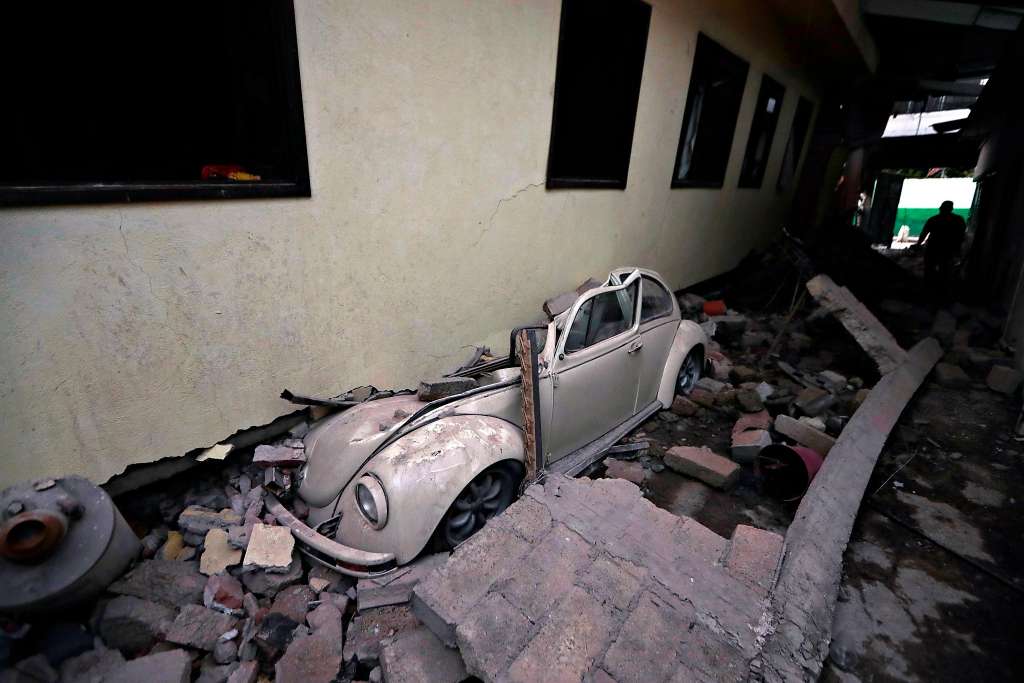
Eduardo Verdugo, Associated Press
The 7.1 magnitude earthquake that shattered buildings and left more than 200 dead in and around Mexico City is another powerful reminder of what could happen when — not if — another major temblor strikes the Bay Area.
“The 500- and 600-year-old buildings, are fine and the new buildings are being carefully built to newer codes,” she said.
Instead, the damage seems to have hit apartment structures put up quickly and cheaply between the 1950s and the 2000, she said.
“A lot of quick-and-dirty building got done,” she said.
In a paper presented at a 2004 Vancouver, B.C., conference on earthquake engineering, two engineering professors at UNAM, Mexico’s premier university, described the problems of meeting earthquake standards in Mexico.
“Nonengineered construction is common in Mexico,” Mario Ordaz and Roberto Meli said in their paper. “As a consequence, a large percentage of the building stock (and in some parts of the country, the vast majority) is built without construction permits, without compliance with codes and without the participation of qualified professionals.”
House, who takes groups of architecture students to Mexico every year through a program called Center for Architecture, Sustainability and Art, said that it’s usually obvious which buildings will survive a quake and which won’t.
“One of the sad things about quick growth is that there are a lot of developers who are not out to build a beautiful community and don’t hire good architects and engineers,” she said.
Kit Miyamoto, CEO of Sacramento’s Miyamoto International, an earthquake safety and structural engineering firm, will be in Mexico City early next week to review the damage and observe the cleanup work. He’ll be working as a consultant to the U.S. State Department and also as a member of the California Seismic Safety Commission, looking to see what the state can learn from the disaster.
“California hasn’t had a real urban disaster since 1906, since Loma Prieta was only a moderate incident,” he said. “We have to learn how cities have to respond. We can learn a lot from this, and we need to be keenly aware of the risks.”
Since the 1985 earthquake, Mexico City has put in place many of the same seismic safety regulations as California. Mexico City also has many of the same-style buildings as California does, Miyamoto said, which makes it important to see just what happened Tuesday.

Photo: Michael Short | Construction worker Yuen Liang attaches angle straps to the top plate of a floor joist.
The quake’s devastation “involved a lot of smaller buildings, not the taller ones that collapsed in 1985,” he added, which suggested a different, sharper type of temblor.
One other problem seen in both Mexico and California is that it too often takes a disaster to provide the push for new and more expansive earthquake safety rules. Just as Mexico City’s 1985 quake brought new regulations on what could be built where, California’s rules have followed deadly quakes.
After the 1933 Long Beach earthquake destroyed or seriously damaged 230 Southern California school buildings, the state passed the Field Act, which required earthquake-resistant construction for school buildings. When 44 people were killed in the collapse of a hospital during the 1971 San Fernando Valley earthquake, new seismic safety rules for hospitals were passed.
In 1989 and 1990, after the Loma Prieta quake, Gov. George Deukmejian signed 137 seismic safety regulations. By contrast, 112 quake bills were signed into law between the 1906 and 1989.
Those rules save lives, Behzad Fatahi, an associate professor of geo-technical and earthquake engineering at the University of Technology Sydney, said in a CNN interview.
“Earthquakes do not kill,” she said. “But inadequately designed and poorly constructed buildings, infrastructure and lifeline systems can.”
By John Wildermuth and J.K. Dineen
